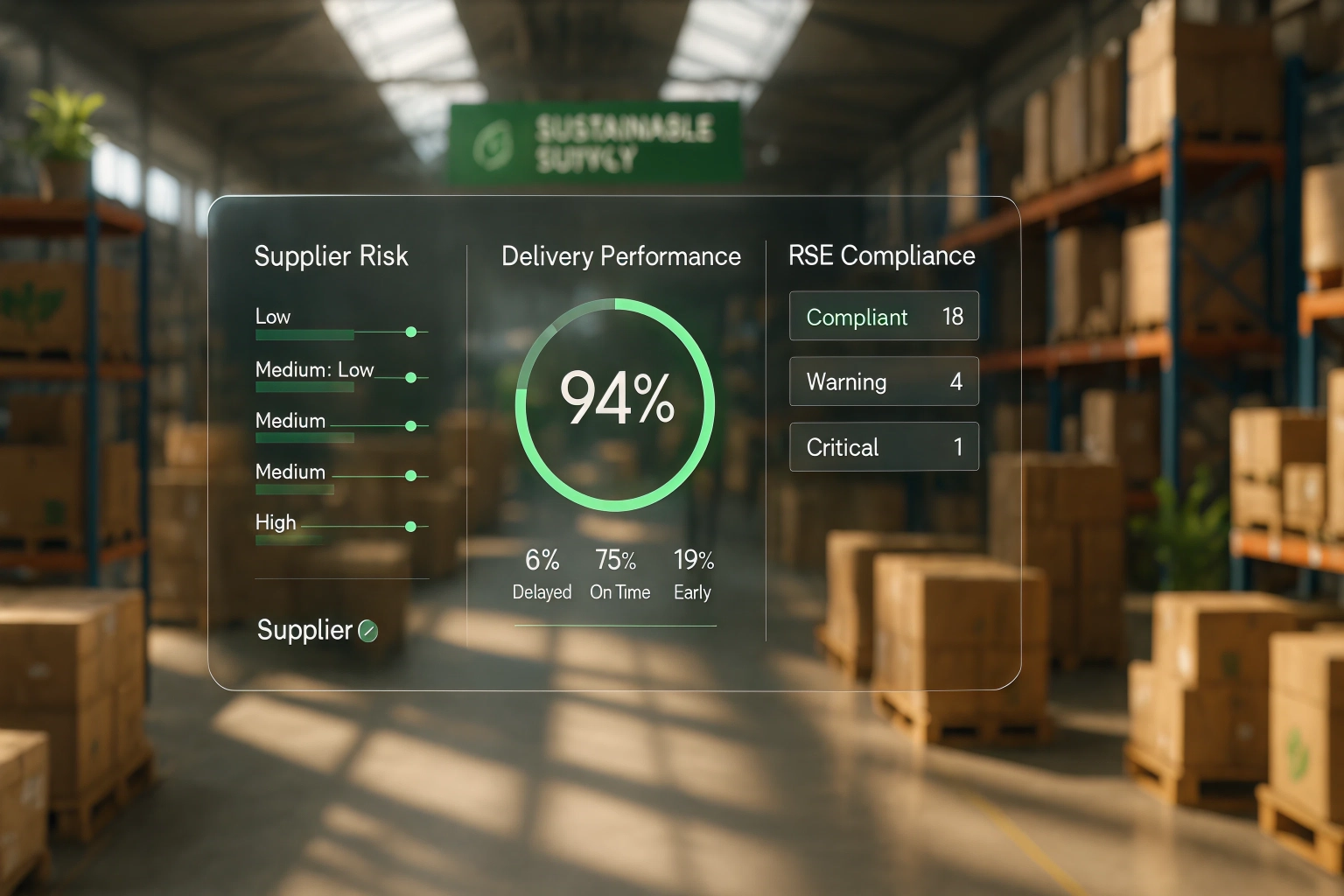Multi-Entity TPRM Deployment for Large Groups: Strategy and Challenges

In a context where large groups are orchestrating increasingly vast ecosystems of third parties, multi-entity deployment of TPRM has become a major strategic imperative. Société Générale exemplifies this reality with 119,000 employees across 62 countries, highlighting the operational complexity of modern multi-site structures. This exponential complexity calls for third-party governance adapted to the challenges of collaborative partner evaluation. But how can you effectively orchestrate regulatory compliance across hundreds of subsidiaries while preserving operational resilience?
What Is Multi-Entity Deployment?
Multi-entity deployment refers to harmonizing the risk evaluation and third-party risk management processes across multiple legal entities within the same group. This goes beyond simple administrative centralization and incorporates a strategic dimension of coordinated supplier risk assessment.
In the public sector, Local Public Enterprises (EPL) embody this complexity well. These multi-entity structures must coordinate the evaluation of their third-party partners while complying with the regulatory requirements of each attached community. The key is to mutualize documentation assessments without compromising local decision-making autonomy.
For large groups in sectors like finance, harmonization requires synchronizing ERP systems with TPRM platforms capable of simultaneously managing regulatory compliance across multiple jurisdictions. This technological convergence optimizes global performance while maintaining operational cohesion across entities.
Why Do International Groups Choose Multi-Site Deployment?
The multi-site model addresses growing competitive and regulatory demands. Large organizations aim to maintain closer geographic proximity to local suppliers while also achieving economies of scale through mutualized third-party risk evaluations.
This strategy is especially effective for construction groups, allowing them to coordinate subcontractor certification across multi-level sites and projects. Rather than duplicating document assessments at each location, a centralized TPRM solution ensures certifications are shared, with local requirements still respected.
Operational resilience is another decisive benefit. By distributing operations across sites, organizations improve their ability to maintain continuity during disruptions. However, this approach requires coordinated monitoring of critical suppliers using a proven risk methodology.
Master the fundamentals of collaborative third-party assessment
For more on collaborative evaluation, see our complete guide to TPRM fundamentals.
Multi-Subsidiary Deployment: A Real-World Example
Successful deployments share similar traits. In the public sector, multi-community EPLs illustrate this model. France Loire, a social housing provider managing 30,000 units, achieved 90% supplier compliance using a mutualized platform that centralized partner evaluations while preserving local autonomy.
This mutualized approach reduced supplier risk evaluation time by 40% thanks to shared certifications across entities. A tailored TPRM solution also enabled multi-jurisdictional compliance and strengthened the group’s operational resilience.
Sector-Specific Strategies for Multi-Subsidiary Organizations
Adapting multi-entity deployment strategies to sector-specific contexts is critical. According to a MBD Consulting study on managing autonomous subsidiaries, high-performing organizations find balance between centralized coordination and local autonomy, enabling “relevant, coordinated, and consistent actions” from each entity.
Construction Sector: Cross-Border Project Coordination
TELT (Tunnel Euralpin Lyon Turin), a Franco-Italian firm managing the Lyon-Turin tunnel construction, exemplifies the challenges of multi-entity coordination in construction. Operating under both French and Italian regulations, TELT adopted a solution that was “very pleasant to use, greatly facilitating user adoption in both France and Italy.”
Such harmonized governance is essential to mitigating fraud, which accounts for 58% of payment risks in the construction industry. Shared evaluations across national borders help reduce exposure and optimize cross-border compliance costs.
Optimize the management of your multi-tier subcontractors.
Explore our dedicated solutions for managing multi-level subcontractors and reducing project compliance risks.
Industrial Sector: Optimizing Multi-Site Supply Chains
Industrial groups face challenges due to complex, multi-entity supply chains. A collaborative approach emphasizes “task interconnection” and “data utilization” through harmonized KPIs across sites.
For ICPE-classified sites, this harmonization simplifies environmental compliance by centralizing certification documentation while maintaining the traceability required by different jurisdictions.
Integrated Financial Management in a Multi-Company Environment
Financial management harmonization is a major challenge for large multi-entity groups. ERP–TPRM integration is key: third-party financial data feeds directly into risk evaluation workflows while planning tools benefit from a consolidated partner performance view.
This integrated model supports multi-currency cash management and payment cycle optimization. One European conglomerate managing 15 industrial and service subsidiaries restructured its financial management based on a proven methodology. Harmonized partner evaluation across divisions reduced month-end closing times by 40% and eliminated most manual consolidation tasks.
Consolidated dashboards allow decision-makers to anticipate liquidity needs while proactively monitoring external partners. This 360° view turns regulatory compliance into a lasting competitive edge.
Multi-entity governance: gain in coherence and performance
Learn how to improve third-party governance in multi-entity environments with our proven sector methodologies.
ERP Systems and Centralized Data
Information system harmonization is a cornerstone of successful multi-entity deployment. According to IBM, 73% of organizations experiencing third-party-related disruptions in the past three years cited poor integration as an aggravating factor. A robust ERP system is essential for orchestrating complete visibility of financial, logistical, and operational processes across divisions.
This centralization optimizes the cash-to-cash cycle by adjusting collection timelines based on a synchronized overview. Real-time access to KPIs helps instantly identify bottlenecks, enhancing adaptability for international groups in volatile economies.
Integrating TPRM Solutions in Multi-Entity Rollouts
As digital ecosystems grow in complexity, large groups face increasing exposure to third-party incidents. Integrating TPRM solutions becomes essential for securing operational continuity across dispersed entities and complying with evolving EU regulations.
Platforms like Aprovall360, which manages 450,000 third parties globally, provide full coverage — from mutualized evaluations of local suppliers to global external partner monitoring. This ensures uninterrupted business continuity and tight control over vulnerable risk areas.
In the industrial sector, this integration simplifies ICPE compliance by centralizing multi-site certifications. Construction companies gain harmonized third-party governance for multi-site subcontractors, significantly lowering non-compliance risks.
Simplifying Deployment While Managing Risk
Recent success stories share a common approach: simplify IT infrastructure while enhancing control through integrated TPRM solutions. This strategy helps overcome the inherent complexity of multi-entity rollouts by streamlining both costs and emerging risk management.
Adopting common technology standards strengthens organizational foundations. Corporate groups taking a collaborative approach see notable gains in operational resilience, a critical factor in fast-moving multinational environments.
ERP–TPRM integration turns multi-entity complexity into a durable competitive advantage. Leading organizations follow a structured change process: pilot on a small scale, validate the benefits, then expand gradually. This proven methodology minimizes deployment risk while maximizing team engagement with the new harmonized third-party governance.
TPRM & Third-Party Governance: Key Takeaways from the Latest Developments
To deepen your understanding of TPRM and third-party governance challenges, explore our full analysis of regulatory and technological evolutions.
These articles might interest you
-
 02 May 2025Third-Party Cybersecurity Assessment: NIS 2 and DORA ComplianceSecteurEuropean companies are facing a major regulatory challenge with the simultaneous implementation of NIS 2 and DORA. These two regulations are radically transforming approaches to cybersecurity and operational resilience, particularly in critical and financial sectors. This convergence requires in-depth multi-regulatory expertise to navigate between specific sectoral obligations and operational synergies. Understanding NIS 2 and DORA […]
02 May 2025Third-Party Cybersecurity Assessment: NIS 2 and DORA ComplianceSecteurEuropean companies are facing a major regulatory challenge with the simultaneous implementation of NIS 2 and DORA. These two regulations are radically transforming approaches to cybersecurity and operational resilience, particularly in critical and financial sectors. This convergence requires in-depth multi-regulatory expertise to navigate between specific sectoral obligations and operational synergies. Understanding NIS 2 and DORA […]Read more
-
 14 June 2025Supplier Evaluation Journey: Optimizing Multi-Regulatory Data CollectionSecteurThe complexity of third-party evaluation is intensifying as regulatory requirements multiply. This reality calls for a reform of internal processes and the adoption of collaborative workflows that are essential to ensure compliance while strengthening operational resilience. Optimizing the evaluation journey involves a structured methodology that streamlines document collection, improves supplier quality, and significantly reduces “supplier fatigue.” This context calls for a […]
14 June 2025Supplier Evaluation Journey: Optimizing Multi-Regulatory Data CollectionSecteurThe complexity of third-party evaluation is intensifying as regulatory requirements multiply. This reality calls for a reform of internal processes and the adoption of collaborative workflows that are essential to ensure compliance while strengthening operational resilience. Optimizing the evaluation journey involves a structured methodology that streamlines document collection, improves supplier quality, and significantly reduces “supplier fatigue.” This context calls for a […]Read more
-
 28 January 2025Third-Party Cybersecurity Benchmark: Assessing and Securing Your Supply Chain in 2025SecteurThird-party cybersecurity has become a major strategic concern for organizations in 2025. According to AgileBuyer, 65% of procurement departments consider supplier failures a critical risk, while 42% list cyberattacks as their second most pressing concern. This challenge is especially acute in certain sectors: 88% of heavy industries anticipate major supplier-related risks, and 68% of IT/Telecom companies […]
28 January 2025Third-Party Cybersecurity Benchmark: Assessing and Securing Your Supply Chain in 2025SecteurThird-party cybersecurity has become a major strategic concern for organizations in 2025. According to AgileBuyer, 65% of procurement departments consider supplier failures a critical risk, while 42% list cyberattacks as their second most pressing concern. This challenge is especially acute in certain sectors: 88% of heavy industries anticipate major supplier-related risks, and 68% of IT/Telecom companies […]Read more
-
 10 February 2025How TPRM and TPGRC Solutions Are Transforming the Retail and Distribution Sector in 2025SecteurThe retail and distribution sector plays a crucial role in the French economy, orchestrating a vast network of subcontractors and suppliers. These stakeholders contribute to both supply chain management and the final customer experience. Among them, installers and delivery partners represent critical links in the value chain. However, this sector faces major challenges: ensuring subcontractor […]
10 February 2025How TPRM and TPGRC Solutions Are Transforming the Retail and Distribution Sector in 2025SecteurThe retail and distribution sector plays a crucial role in the French economy, orchestrating a vast network of subcontractors and suppliers. These stakeholders contribute to both supply chain management and the final customer experience. Among them, installers and delivery partners represent critical links in the value chain. However, this sector faces major challenges: ensuring subcontractor […]Read more
